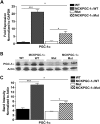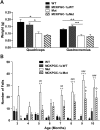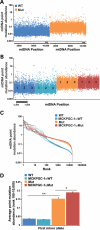Increased mitochondrial biogenesis in muscle improves aging phenotypes in the mtDNA mutator mouse
- PMID: 22357654
- PMCID: PMC3335313
- DOI: 10.1093/hmg/dds049
Increased mitochondrial biogenesis in muscle improves aging phenotypes in the mtDNA mutator mouse
Abstract
Aging is an intricate process that increases susceptibility to sarcopenia and cardiovascular diseases. The accumulation of mitochondrial DNA (mtDNA) mutations is believed to contribute to mitochondrial dysfunction, potentially shortening lifespan. The mtDNA mutator mouse, a mouse model with a proofreading-deficient mtDNA polymerase γ, was shown to develop a premature aging phenotype, including sarcopenia, cardiomyopathy and decreased lifespan. This phenotype was associated with an accumulation of mtDNA mutations and mitochondrial dysfunction. We found that increased expression of peroxisome proliferator-activated receptor γ coactivator-1α (PGC-1α), a crucial regulator of mitochondrial biogenesis and function, in the muscle of mutator mice increased mitochondrial biogenesis and function and also improved the skeletal muscle and heart phenotypes of the mice. Deep sequencing analysis of their mtDNA showed that the increased mitochondrial biogenesis did not reduce the accumulation of mtDNA mutations but rather caused a small increase. These results indicate that increased muscle PGC-1α expression is able to improve some premature aging phenotypes in the mutator mice without reverting the accumulation of mtDNA mutations.
Figures





References
-
- Figueiredo P.A., Mota M.P., Appell H.J., Duarte J.A. The role of mitochondria in aging of skeletal muscle. Biogerontology. 2008;9:67–84. doi:10.1007/s10522-007-9121-7. - DOI - PubMed
-
- Meissner C., Bruse P., Oehmichen M. Tissue-specific deletion patterns of the mitochondrial genome with advancing age. Exp. Gerontol. 2006;41:518–524. doi:10.1016/j.exger.2006.03.010. - DOI - PubMed
-
- Meissner C. Mutations of mitochondrial DNA—cause or consequence of the ageing process? Z. Gerontol. Geriatr. 2007;40:325–333. doi:10.1007/s00391-007-0481-z. - DOI - PubMed
-
- Taylor R.W., Turnbull D.M. Mitochondrial DNA mutations in human disease. Nat. Rev. Genet. 2005;6:389–402. doi:10.1038/nrg1606. - DOI - PMC - PubMed
-
- Loeb L.A., Wallace D.C., Martin G.M. The mitochondrial theory of aging and its relationship to reactive oxygen species damage and somatic mtDNA mutations. Proc. Natl Acad. Sci. USA. 2005;102:18769–18770. doi:10.1073/pnas.0509776102. - DOI - PMC - PubMed
Publication types
MeSH terms
Substances
Grants and funding
LinkOut - more resources
Full Text Sources
Other Literature Sources
Medical
Molecular Biology Databases

